Insights into the Machine Learning Predictions of the Optical Response of Plasmon@Semiconductor Core-Shell Nanocylinders
Abstract
:1. Introduction
2. Materials and Methods
2.1. FDTD Simulations
2.2. CNN and MLP Architectures and Implementations
3. Results and Discussion
3.1. FDTD Simulation Results
3.2. Training of PPRN and SGN
3.3. Comparison between the Results Obtained by PPRN and SGN, with FDTD Simulations
3.4. Interpreting the PPRN and SGN
4. Conclusions
Author Contributions
Funding
Institutional Review Board Statement
Informed Consent Statement
Data Availability Statement
Conflicts of Interest
References
- Gutierrez, Y.; Brown, A.S.; Moreno, F.; Losurdo, M. Plasmonics beyond noble metals: Exploiting phase and compositional changes for manipulating plasmonic performance. J. Appl. Phys. 2020, 128, 080901. [Google Scholar] [CrossRef]
- Farsinezhad, S.; Shanavas, T.; Mahdi, N.; Askar, A.M.; Kar, P.; Sharma, H.; Shankar, K. Core–shell titanium dioxide–titanium nitride nanotube arrays with near-infrared plasmon resonances. Nanotechnology 2018, 29, 154006. [Google Scholar] [CrossRef] [PubMed]
- Bhattacharya, C.; Saji, S.E.; Mohan, A.; Madav, V.; Jia, G.H.; Yin, Z.Y. Sustainable Nanoplasmon-Enhanced Photoredox Reactions: Synthesis, Characterization, and Applications. Adv. Energy Mater. 2020, 10, 2002402. [Google Scholar] [CrossRef]
- Karaballi, R.A.; Monfared, Y.E.; Dasog, M. Overview of Synthetic Methods to Prepare Plasmonic Transition-Metal Nitride Nanoparticles. Chem.—A Eur. J. 2020, 26, 8499–8505. [Google Scholar] [CrossRef] [PubMed]
- Lucena-Serrano, C.; Contreras-Caceres, R.; Sanchez-Molina, M.; Casado-Rodriguez, M.A.; Cloarec, J.M.; Mainetti, E.; Lopez-Romero, M. Preparation and Application of Non-spherical Metal Nanoparticles: Reality and Perspective. Curr. Org. Chem. 2017, 21, 2338–2359. [Google Scholar] [CrossRef]
- Hughes, R.A.; Menumerov, E.; Neretina, S. When lithography meets self-assembly: A review of recent advances in the directed assembly of complex metal nanostructures on planar and textured surfaces. Nanotechnology 2017, 28, 282002. [Google Scholar] [CrossRef]
- Tabatabaei, M.; Najiminaini, M.; Davieau, K.; Kaminska, B.; Singh, M.R.; Carson, J.J.; Lagugné-Labarthet, F. Tunable 3D plasmonic cavity nanosensors for surface-enhanced Raman spectroscopy with sub-femtomolar limit of detection. Acs Photonics 2015, 2, 752–759. [Google Scholar] [CrossRef] [Green Version]
- Hada, A.M.; Potara, M.; Suarasan, S.; Vulpoi, A.; Nagy-Simon, T.; Licarete, E.; Astilean, S. Fabrication of gold–silver core–shell nanoparticles for performing as ultrabright SERS-nanotags inside human ovarian cancer cells. Nanotechnology 2019, 30, 315701. [Google Scholar] [CrossRef]
- Manuel, A.P.; Kirkey, A.; Mahdi, N.; Shankar, K. Plexcitonics—Fundamental principles and optoelectronic applications. J. Mater. Chem. C 2019, 7, 1821–1853. [Google Scholar] [CrossRef]
- Wang, P.; Nasir, M.E.; Krasavin, A.V.; Dickson, W.; Jiang, Y.; Zayats, A.V. Plasmonic Metamaterials for Nanochemistry and Sensing. Acc. Chem. Res. 2019, 52, 3018–3028. [Google Scholar] [CrossRef]
- Palermo, G.; Sreekanth, K.V.; Strangi, G. Hyperbolic dispersion metamaterials and metasurfaces. EPJ Appl. Metamaterials 2021, 7, 11. [Google Scholar] [CrossRef]
- Zhang, D.; Lu, P.; Misra, S.; Wissel, A.; He, Z.H.; Qi, Z.M.; Gao, X.Y.; Sun, X.; Liu, J.C.; Lu, J.J.; et al. Design of 3D Oxide–Metal Hybrid Metamaterial for Tailorable Light–Matter Interactions in Visible and Near-Infrared Region. Adv. Opt. Mater. 2021, 9, 2001154. [Google Scholar] [CrossRef]
- Zeng, S.; Vahidzadeh, E.; VanEssen, C.G.; Kar, P.; Kisslinger, R.; Goswami, A.; Zhang, Y.; Mahdi, N.; Riddell, S.; Kobryn, A.E.; et al. Optical control of selectivity of high rate CO2 photoreduction via interband- or hot electron Z-scheme reaction pathways in Au-TiO2 plasmonic photonic crystal photocatalyst. Appl. Catal. B Environ. 2020, 267, 118644. [Google Scholar] [CrossRef]
- Vahidzadeh, E.; Zeng, S.; Manuel, A.P.; Riddell, S.; Kumar, P.; Alam, K.M.; Shankar, K. Asymmetric Multipole Plasmon-Mediated Catalysis Shifts the Product Selectivity of CO2 Photoreduction toward C2+ Products. Acs Appl. Mater. Interfaces 2021, 13, 7248–7258. [Google Scholar] [CrossRef]
- Rajender, G.; Choudhury, B.; Giri, P.K. In situ decoration of plasmonic Au nanoparticles on graphene quantum dots-graphitic carbon nitride hybrid and evaluation of its visible light photocatalytic performance. Nanotechnology 2017, 28, 395703. [Google Scholar] [CrossRef] [Green Version]
- Vahidzadeh, E.; Zeng, S.; Alam, K.M.; Kumar, P.; Riddell, S.; Chaulagain, N.; Gusarov, S.; Kobryn, A.E.; Shankar, K. Harvesting Hot Holes in Plasmon-Coupled Ultrathin Photoanodes for High-Performance Photoelectrochemical Water Splitting. ACS Appl. Mater. Interfaces 2021, 13, 42741–42752. [Google Scholar] [CrossRef]
- Kisslinger, R.; Riddell, S.; Manuel, A.P.; Alam, K.M.; Kalra, A.P.; Cui, K.; Shankar, K. Nonlithographic Formation of Ta2O5 Nanodimple Arrays Using Electrochemical Anodization and Their Use in Plasmonic Photocatalysis for Enhancement of Local Field and Catalytic Activity. Acs Appl. Mater. Interfaces 2021, 13, 4340–4351. [Google Scholar] [CrossRef]
- Zhong, H.X.; Wei, Y.; Yue, Y.Z.; Zhang, L.H.; Liu, Y. Preparation of core–shell Ag@CeO2 nanocomposite by LSPR photothermal induced interface reaction. Nanotechnology 2016, 27, 135701. [Google Scholar] [CrossRef]
- Lavie, A.; Yadgarov, L.; Houben, L.; Popovitz-Biro, R.; Shaul, T.E.; Nagler, A.; Suchowski, H.; Tenne, R. Synthesis of core-shell single-layer MoS2 sheathing gold nanoparticles, AuNP@1L-MoS2. Nanotechnology 2017, 28, 24LT03. [Google Scholar] [CrossRef]
- Rivera, V.A.G.; Silva, O.; Ledemi, Y.; Messaddeq, Y.; Marega, E., Jr. Collective Plasmon-Modes in Gain Media: Quantum Emitters and Plasmonic Nanostructures; Springer: Berlin/Heidelberg, Germany, 2014. [Google Scholar]
- Abrashuly, A.; Valagiannopoulos, C. Limits for absorption and scattering by core-shell nanowires in the visible spectrum. Phys. Rev. Appl. 2019, 11, 014051. [Google Scholar] [CrossRef]
- Sheu, T.W.; Wang, Y.; Li, J. Development of a 3D staggered FDTD scheme for solving Maxwell’s equations in Drude medium. Comput. Math. Appl. 2016, 71, 1198–1226. [Google Scholar] [CrossRef]
- Furse, C.M. Application of the finite-difference time-domain method to bio-electromagnetic simulations. Appl. Comput. Electromagn. Soc. Newsl. 1997, 12, 28–57. [Google Scholar]
- Gorodetsky, D.A.; Wilsey, P.A. Reduction of FDTD simulation time with modal methods. PIERS Online 2006, 2, 510–513. [Google Scholar] [CrossRef] [Green Version]
- Lee, D.; Kim, T.; Park, Q.-H. Performance analysis of parallelized PSTD-FDTD method for large-scale electromagnetic simulation. Comput. Phys. Commun. 2021, 259, 107631. [Google Scholar] [CrossRef]
- Lesina, A.C.; Vaccari, A.; Berini, P.; Ramunno, L. On the convergence and accuracy of the FDTD method for nanoplasmonics. Opt. Express 2015, 23, 10481–10497. [Google Scholar] [CrossRef] [Green Version]
- Griffiths, L. Performing 3-D FDTD simulations in less than 3 seconds on a personal computer and its application to genetic algorithm antenna optimization. Appl. Comput. Electromagn. Soc. J. 2005, 20, 128–135. [Google Scholar]
- Vahidzadeh, E.; Shankar, K. Artificial Neural Network-Based Prediction of the Optical Properties of Spherical Core–Shell Plasmonic Metastructures. Nanomaterials 2021, 11, 633. [Google Scholar] [CrossRef]
- Lumerical. Symmetric and Anti-Symmetric BCs in FDTD and MODE. Available online: https://support.lumerical.com/hc/en-us/articles/360034382694-Symmetric-and-anti-symmetric-BCs-in-FDTD-and-MODE (accessed on 11 June 2022).
- El Shamy, R.S.; Swillam, M.; Obayya, S. Full 3D electromagnetic wave analysis using 2D simulation. In Proceedings of the 2017 International Applied Computational Electromagnetics Society Symposium-Italy (ACES), Firenze, Italy, 26–30 March 2017; pp. 1–2. [Google Scholar]
- Sajedian, I.; Kim, J.; Rho, J. Finding the optical properties of plasmonic structures by image processing using a combination of convolutional neural networks and recurrent neural networks. Microsyst. Nanoeng. 2019, 5, 27. [Google Scholar] [CrossRef] [Green Version]
- He, J.; He, C.; Zheng, C.; Wang, Q.; Ye, J. Plasmonic nanoparticle simulations and inverse design using machine learning. Nanoscale 2019, 11, 17444–17459. [Google Scholar] [CrossRef]
- Peurifoy, J.; Shen, Y.; Jing, L.; Yang, Y.; Cano-Renteria, F.; DeLacy, B.G.; Joannopoulos, J.D.; Tegmark, M.; Soljačić, M. Nanophotonic particle simulation and inverse design using artificial neural networks. Sci. Adv. 2018, 4, eaar4206. [Google Scholar] [CrossRef] [Green Version]
- Pilozzi, L.; Farrelly, F.A.; Marcucci, G.; Conti, C. Topological nanophotonics and artificial neural networks. Nanotechnology 2021, 32, 142001. [Google Scholar] [CrossRef]
- Parker, A.J.; Motevalli, B.; Opletal, G.; Barnard, A.S. The pure and representative types of disordered platinum nanoparticles from machine learning. Nanotechnology 2021, 32, 095404. [Google Scholar] [CrossRef]
- Yan, R.Q.; Wang, T.; Jiang, X.Y.; Zhong, Q.F.; Huang, X.; Wang, L.; Yue, X.Z. Design of high-performance plasmonic nanosensors by particle swarm optimization algorithm combined with machine learning. Nanotechnology 2020, 31, 375202. [Google Scholar] [CrossRef]
- Kalinin, S.V.; Roccapriore, K.M.; Cho, S.H.; Milliron, D.J.; Vasudevan, R.; Ziatdinov, M.; Hachtel, J.A. Separating Physically Distinct Mechanisms in Complex Infrared Plasmonic Nanostructures via Machine Learning Enhanced Electron Energy Loss Spectroscopy. Adv. Opt. Mater. 2021, 9, 2001808. [Google Scholar] [CrossRef]
- Akashi, N.; Toma, M.; Kajikawa, K. Design by neural network of concentric multilayered cylindrical metamaterials. Appl. Phys. Express 2020, 13, 042003. [Google Scholar] [CrossRef]
- Hu, B.; Wu, B.; Tan, D.; Xu, J.; Chen, Y. Robust inverse-design of scattering spectrum in core-shell structure using modified denoising autoencoder neural network. Opt. Express 2019, 27, 36276–36285. [Google Scholar] [CrossRef]
- So, S.; Mun, J.; Rho, J. Simultaneous inverse design of materials and structures via deep learning: Demonstration of dipole resonance engineering using core–shell nanoparticles. ACS Appl. Mater. Interfaces 2019, 11, 24264–24268. [Google Scholar] [CrossRef]
- Gao, L.; Li, X.; Liu, D.; Wang, L.; Yu, Z. A bidirectional deep neural network for accurate silicon color design. Adv. Mater. 2019, 31, 1905467. [Google Scholar] [CrossRef]
- Sheverdin, A.; Monticone, F.; Valagiannopoulos, C. Photonic Inverse Design with Neural Networks: The Case of Invisibility in the Visible. Phys. Rev. Appl. 2020, 14, 024054. [Google Scholar] [CrossRef]
- Wiecha, P.R.; Muskens, O.L. Deep learning meets nanophotonics: A generalized accurate predictor for near fields and far fields of arbitrary 3D nanostructures. Nano Lett. 2019, 20, 329–338. [Google Scholar] [CrossRef] [Green Version]
- Stolt, T.; Kim, J.; Héron, S.; Vesala, A.; Huttunen, M.J.; Czaplicki, R.; Zang, X.; Kauranen, M.; Rho, J.; Genevet, P. Three-dimensional nonlinear plasmonic metamaterials. In Proceedings of Nanophotonics VIII.; SPIE: Bellingham, WA, USA, 2020; p. 113451T. [Google Scholar]
- Fu, X.; Cui, T.J. Recent progress on metamaterials: From effective medium model to real-time information processing system. Prog. Quantum Electron. 2019, 67, 100223. [Google Scholar] [CrossRef]
- Cui, Y.; He, Y.; Jin, Y.; Ding, F.; Yang, L.; Ye, Y.; Zhong, S.; Lin, Y.; He, S. Plasmonic and metamaterial structures as electromagnetic absorbers. Laser Photonics Rev. 2014, 8, 495–520. [Google Scholar] [CrossRef] [Green Version]
- Zeng, S.; Muneshwar, T.; Riddell, S.; Manuel, A.P.; Vahidzadeh, E.; Kisslinger, R.; Kumar, P.; Alam, K.M.M.; Kobryn, A.E.; Gusarov, S.; et al. TiO2-HfN Radial Nano-Heterojunction: A Hot Carrier Photoanode for Sunlight-Driven Water-Splitting. Catalysts 2021, 11, 1374. [Google Scholar] [CrossRef]
- Manuel, A.P.; Barya, P.; Riddell, S.; Zeng, S.; Alam, K.M.; Shankar, K. Plasmonic photocatalysis and SERS sensing using ellipsometrically modeled Ag nanoisland substrates. Nanotechnology 2020, 31, 365301. [Google Scholar] [CrossRef] [PubMed]
- Capoglu, I.R.; Smith, G.S. A total-field/scattered-field plane-wave source for the FDTD analysis of layered media. IEEE Trans. Antennas Propag. 2008, 56, 158–169. [Google Scholar] [CrossRef]
- Siefke, T.; Kroker, S.; Pfeiffer, K.; Puffky, O.; Dietrich, K.; Franta, D.; Ohlídal, I.; Szeghalmi, A.; Kley, E.B.; Tünnermann, A. Materials pushing the application limits of wire grid polarizers further into the deep ultraviolet spectral range. Adv. Opt. Mater. 2016, 4, 1780–1786. [Google Scholar] [CrossRef]
- Kingma, D.P.; Ba, J. Adam: A method for stochastic optimization. arXiv 2014, arXiv:1412.6980. [Google Scholar]
- Garcia, J.; Wilson, E.; Aggarwal, D.; Rajashekhar, H.; Kumar, N.; Shankar, K. Identifying Plasmon-Exciton Coupling in Au Nanoislands Coated with Thin Films of J-Aggregates. In Proceedings of the 2022 IEEE Sensors, Dallas, TX, USA, 30 October 2022; pp. 1–4. [Google Scholar]
- Kim, K.-H.; No, Y.-S. Subwavelength core/shell cylindrical nanostructures for novel plasmonic and metamaterial devices. Nano Converg. 2017, 4, 32. [Google Scholar] [CrossRef] [Green Version]
- Lobet, M.; Henrard, L. Metamaterials for ultra-broadband super absorbers based on plasmon hybridization. In Proceedings of the 2014 8th International Congress on Advanced Electromagnetic Materials in Microwaves and Optics, Copenhagen, Denmark, 25–28 August 2014; pp. 190–192. [Google Scholar]
- Ogawa, S.; Kimata, M. Metal-insulator-metal-based plasmonic metamaterial absorbers at visible and infrared wavelengths: A review. Materials 2018, 11, 458. [Google Scholar] [CrossRef] [Green Version]
- Yeung, C.; Tsai, J.-M.; King, B.; Kawagoe, Y.; Ho, D.; Knight, M.W.; Raman, A.P. Elucidating the behavior of nanophotonic structures through explainable machine learning algorithms. ACS Photonics 2020, 7, 2309–2318. [Google Scholar] [CrossRef]
- Lundberg, S.M.; Erion, G.; Chen, H.; DeGrave, A.; Prutkin, J.M.; Nair, B.; Katz, R.; Himmelfarb, J.; Bansal, N.; Lee, S.-I. From local explanations to global understanding with explainable AI for trees. Nat. Mach. Intell. 2020, 2, 56–67. [Google Scholar] [CrossRef]
- Lundberg, S.; Lee, S.-I. A unified approach to interpreting model predictions. arXiv 2017, arXiv:1705.07874. [Google Scholar]
- Liu, D.; Tan, Y.; Khoram, E.; Yu, Z. Training deep neural networks for the inverse design of nanophotonic structures. Acs Photonics 2018, 5, 1365–1369. [Google Scholar] [CrossRef] [Green Version]
- So, S.; Badloe, T.; Noh, J.; Bravo-Abad, J.; Rho, J. Deep learning enabled inverse design in nanophotonics. Nanophotonics 2020, 9, 1041–1057. [Google Scholar] [CrossRef] [Green Version]
- Ider, M.; Abderrafi, K.; Eddahbi, A.; Ouaskit, S.; Kassiba, A. Silver metallic nanoparticles with surface plasmon resonance: Synthesis and characterizations. J. Clust. Sci. 2017, 28, 1051–1069. [Google Scholar] [CrossRef]
- Mekshun, A.; Moritaka, S.; Kondorskii, A.; Lebedev, V. Comparative Analysis of Optical Spectra of Plasmonic Nanoparticles of Different Geometrical Shapes. Bull. Lebedev Phys. Inst. 2020, 47, 276–279. [Google Scholar] [CrossRef]
- Luo, J.; Li, X.; Zhang, X.; Guo, J.; Liu, W.; Lai, Y.; Zhan, Y.; Huang, M. Deep-learning-enabled inverse engineering of multi-wavelength invisibility-to-superscattering switching with phase-change materials. Opt. Express 2021, 29, 10527–10537. [Google Scholar] [CrossRef]
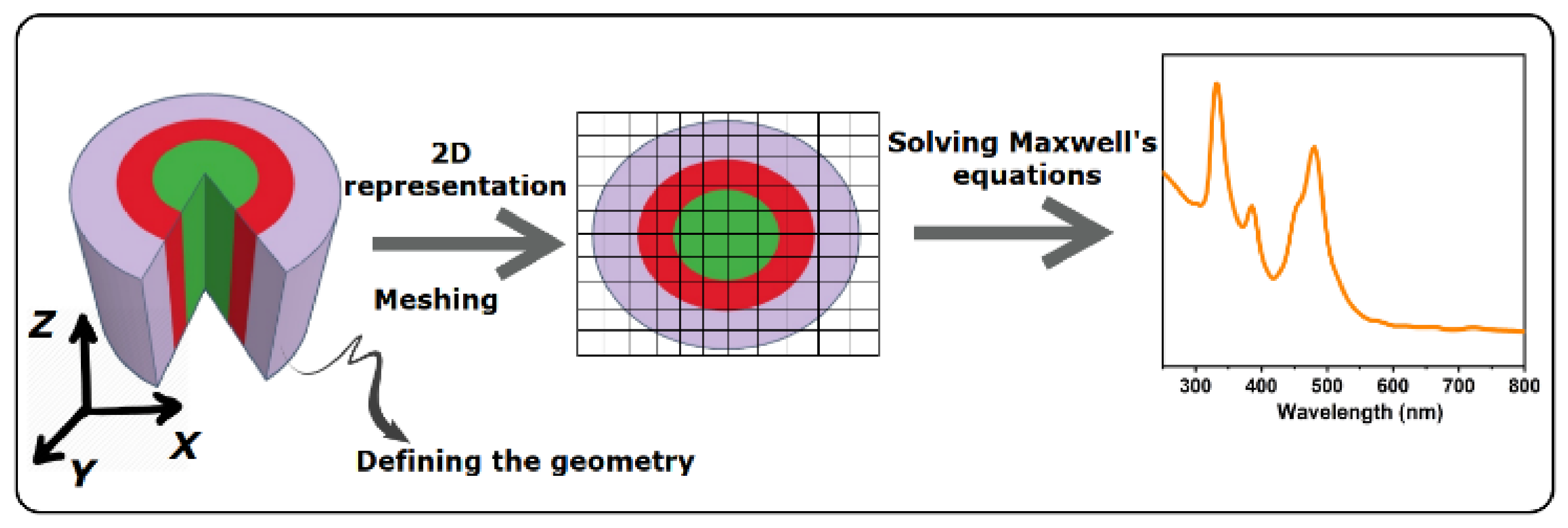


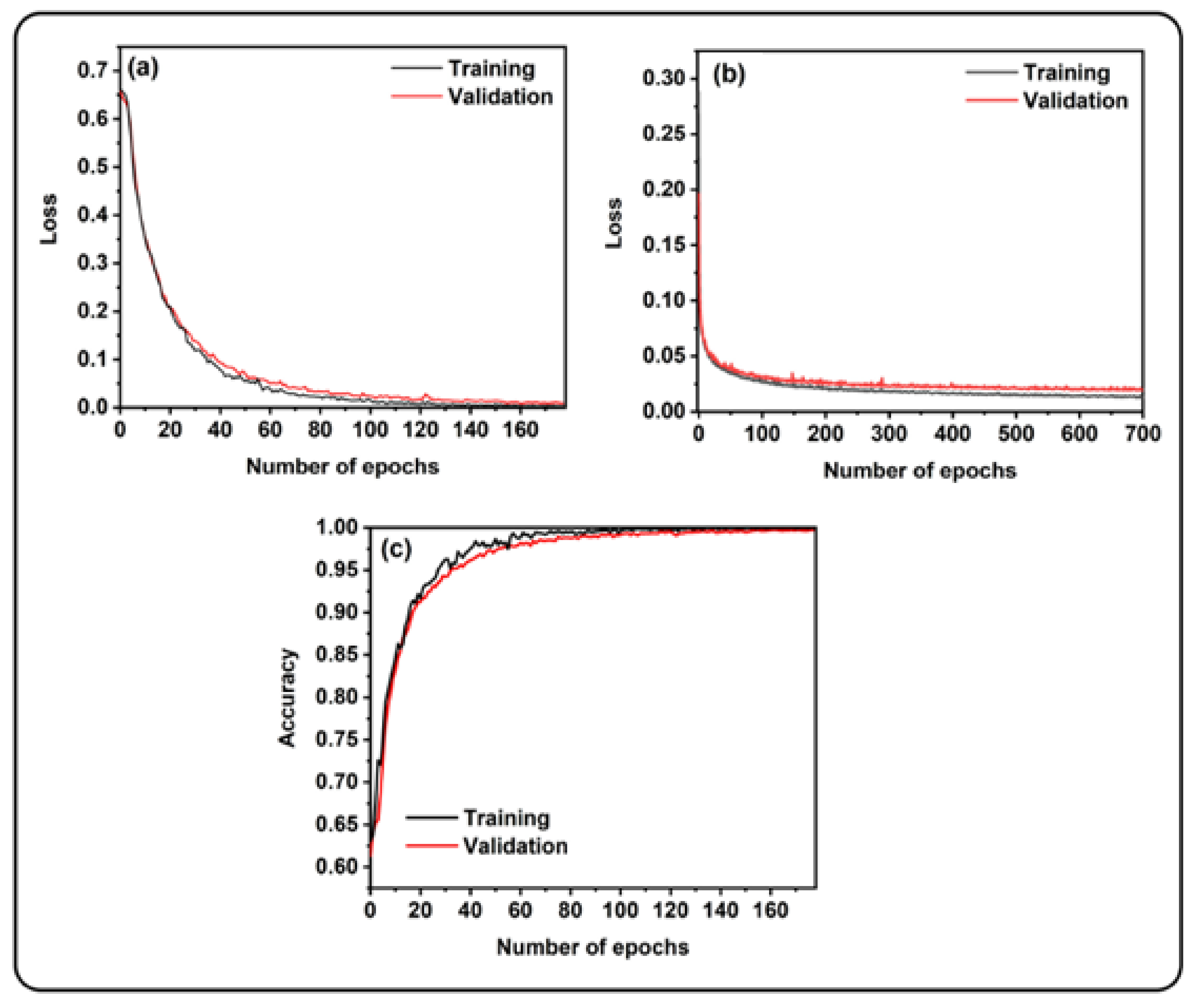
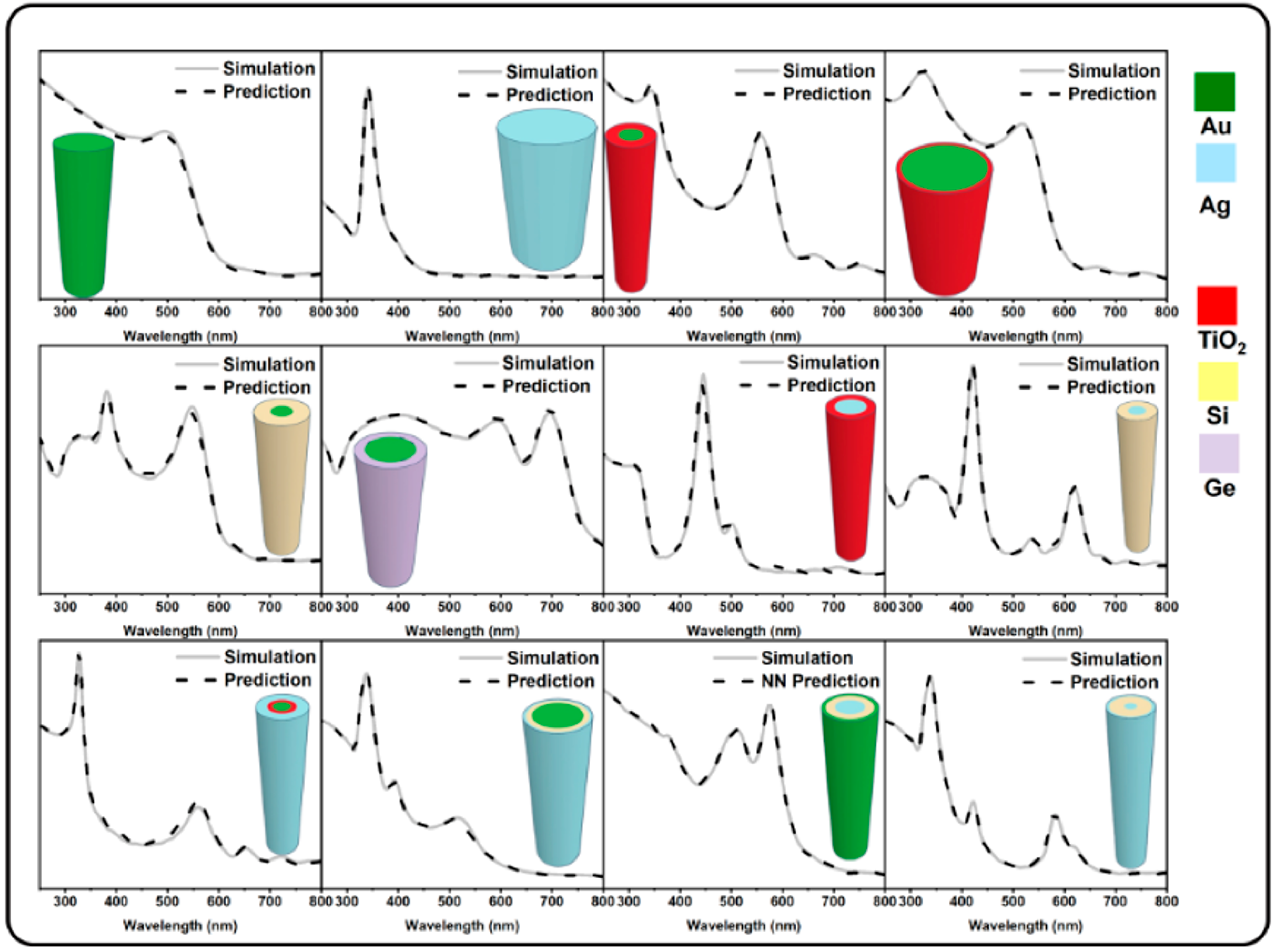
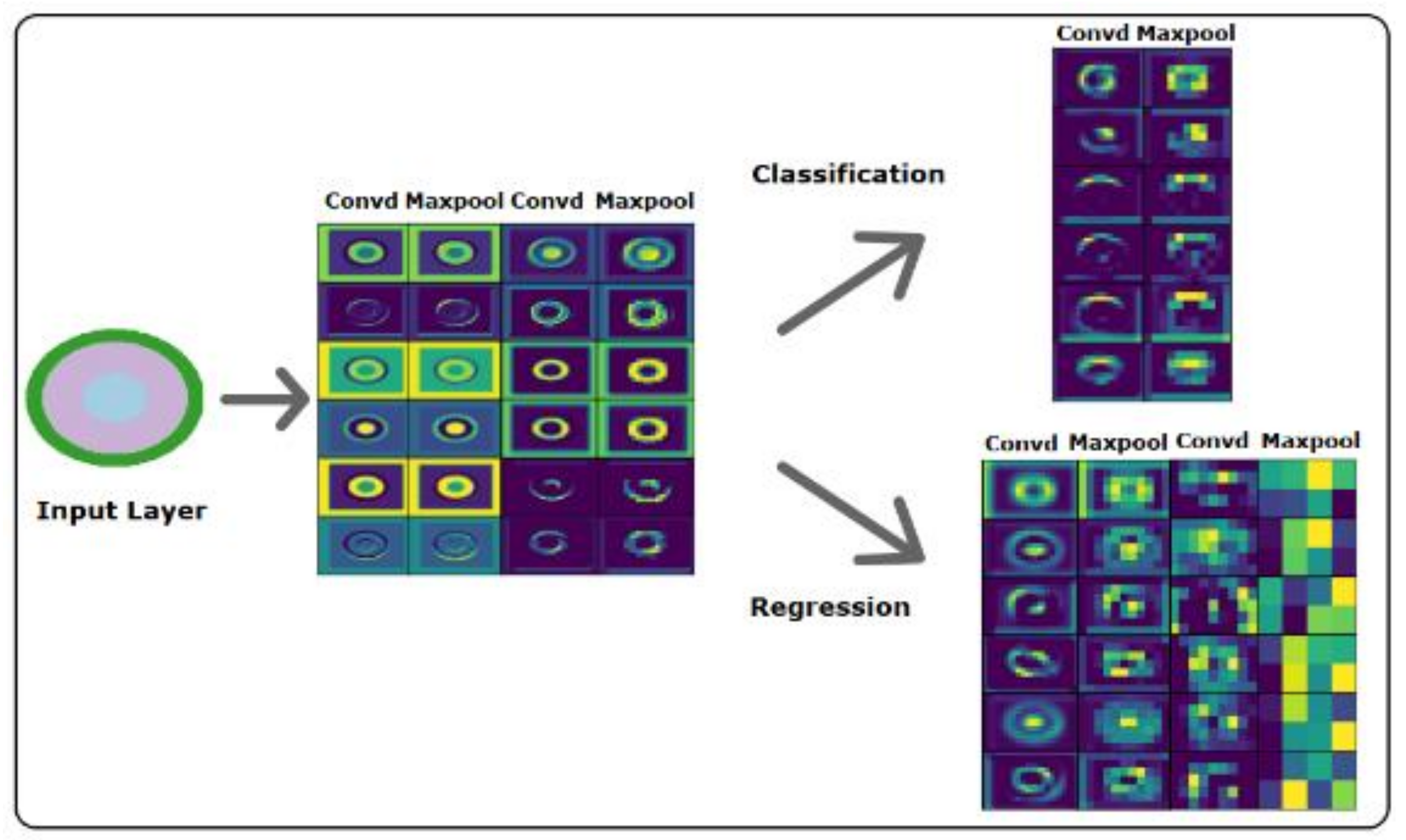
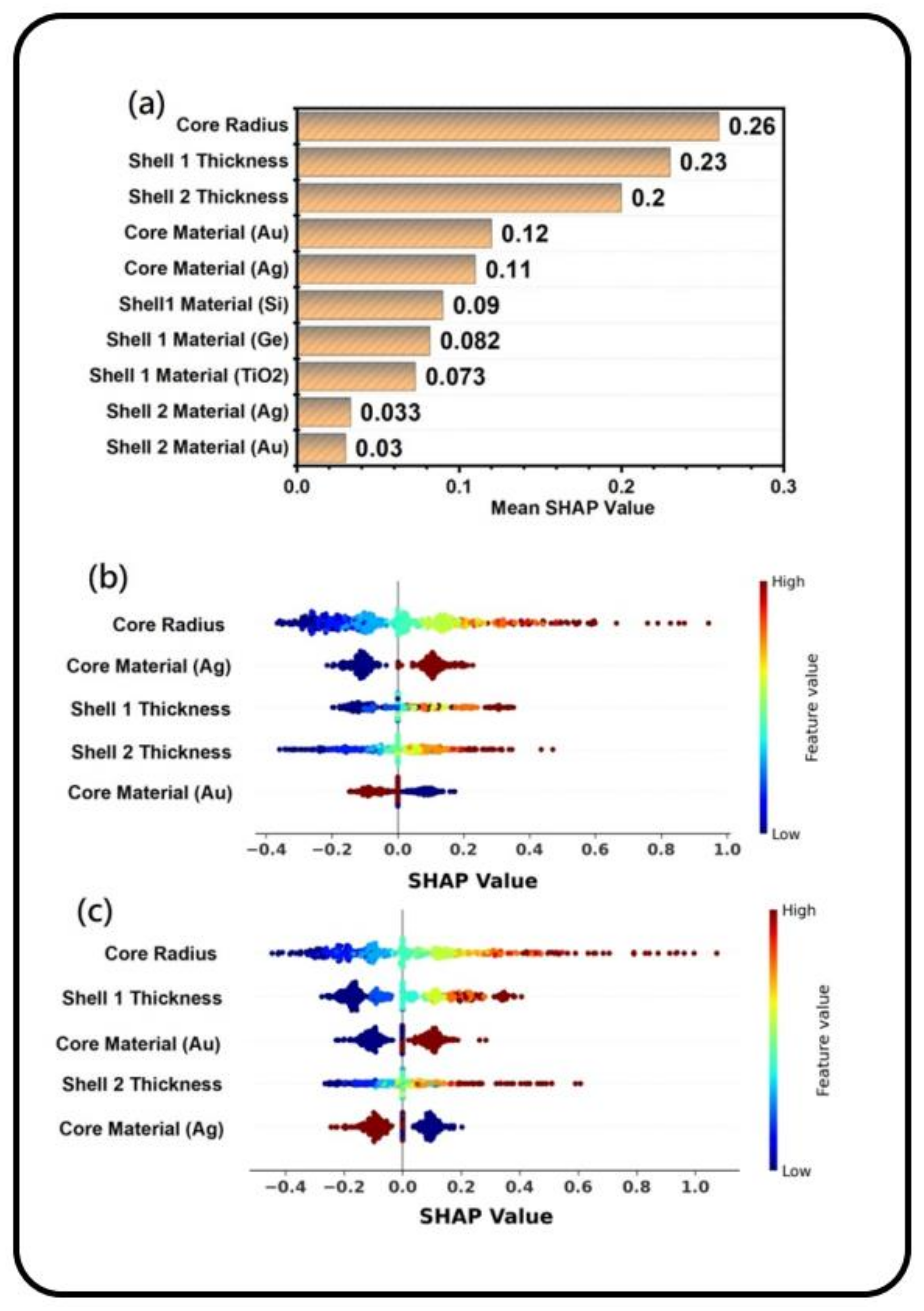
| Number of Layers | Core Materials | 1st Layer Materials | 2nd Layer Materials | Core Radii Range (nm) | 1st Layer’s Thickness Range (nm) | 2nd Layer’s Thickness Range (nm) |
|---|---|---|---|---|---|---|
| 1 | Au, Ag | NA | NA | 5–75 | NA | NA |
| 2 | Au, Ag | Si, Ge, TiO2 | NA | 5–40 | 5–40 | NA |
| 3 | Au, Ag | Si, Ge, TiO2 | Au, Ag | 5–25 | 5–25 | 5–25 |
| Categorical Features | Continuous Features | ||||||||
|---|---|---|---|---|---|---|---|---|---|
| Core Material (Au) | Core Material (Ag) | Shell1 Material (TiO2) | Shell1 Material (Si) | Shell1 Material (Ge) | Shell2 Material (Au) | Shell2 Material (Ag) | Core Radius | Shell1 Thickness | Shell2 Thickness |
| SGN Architectures | Activation for the Hidden Layers | Validation Error |
|---|---|---|
| {1024,1024,200} (used in this study) | relu | 0.019 |
| {1024,1024,200} | tanh | 0.034 |
| {1024,1024,500,200} | relu | 0.025 |
| {512,200} | relu | 0.055 |
Disclaimer/Publisher’s Note: The statements, opinions and data contained in all publications are solely those of the individual author(s) and contributor(s) and not of MDPI and/or the editor(s). MDPI and/or the editor(s) disclaim responsibility for any injury to people or property resulting from any ideas, methods, instructions or products referred to in the content. |
© 2023 by the authors. Licensee MDPI, Basel, Switzerland. This article is an open access article distributed under the terms and conditions of the Creative Commons Attribution (CC BY) license (https://creativecommons.org/licenses/by/4.0/).
Share and Cite
Vahidzadeh, E.; Shankar, K. Insights into the Machine Learning Predictions of the Optical Response of Plasmon@Semiconductor Core-Shell Nanocylinders. Photochem 2023, 3, 155-170. https://doi.org/10.3390/photochem3010010
Vahidzadeh E, Shankar K. Insights into the Machine Learning Predictions of the Optical Response of Plasmon@Semiconductor Core-Shell Nanocylinders. Photochem. 2023; 3(1):155-170. https://doi.org/10.3390/photochem3010010
Chicago/Turabian StyleVahidzadeh, Ehsan, and Karthik Shankar. 2023. "Insights into the Machine Learning Predictions of the Optical Response of Plasmon@Semiconductor Core-Shell Nanocylinders" Photochem 3, no. 1: 155-170. https://doi.org/10.3390/photochem3010010
APA StyleVahidzadeh, E., & Shankar, K. (2023). Insights into the Machine Learning Predictions of the Optical Response of Plasmon@Semiconductor Core-Shell Nanocylinders. Photochem, 3(1), 155-170. https://doi.org/10.3390/photochem3010010







